Carb counting is one of the most powerful tools for managing diabetes, but it’s not always easy. Even experienced counters make mistakes that can affect blood sugar control. The good news is that most of these errors are avoidable with a little awareness and practice. Let’s look at the most common carb counting mistakes—and how to fix them.
1. Misjudging Portion Sizes
The mistake: Estimating rather than measuring, which often leads to under- or over-counting carbs. For example, thinking a large bagel has 30g carbs when in reality it may be closer to 40g.
How to avoid it:
-
Use measuring cups and a food scale at home until you get comfortable eyeballing portions.
-
Remember that restaurant servings are often 2–3 times larger than standard portions.
2. Forgetting “Hidden Carbs”
The mistake: Overlooking carbs in condiments, sauces, dressings, and drinks. That extra dollop of ketchup or sweetened coffee can add up.
How to avoid it:
-
Check nutrition labels for condiments and packaged drinks.
-
When dining out, ask for sauces and dressings on the side.
-
Choose unsweetened or sugar-free versions when possible.
3. Ignoring Fibre
The mistake: Counting total carbs without accounting for fibre. Fibre isn’t fully digested, so it doesn’t raise blood sugar the same way. Not everyone counts fiber, take care if doing so and check with your dietitian or specialist first.
How to avoid it:
-
If a food has more than 5g of fibre per serving, subtract it from the total carbs to get net carbs.
-
Choose fibre-rich foods like whole grains, beans, and vegetables to help stabilise blood sugar.
4. Not Accounting for Beverages
The mistake: Forgetting that drinks can contain carbs too. Regular soda, fruit juices, and even fancy coffee drinks can cause spikes.
How to avoid it:
-
Stick to water, sparkling water, or unsweetened tea/coffee.
-
If you do have juice or soda, log it and count the carbs just like food.
5. Relying Too Heavily on Apps Without Cross-Checking
The mistake: Using a carb counting app but not checking the accuracy of entries. Some databases include user-uploaded data, which can be incorrect.
How to avoid it:
-
Cross-check app data with food packaging labels when possible.
-
Save “trusted foods” in your app for quick reuse.
6. Forgetting Snacks and “Nibbles”
The mistake: Not logging small snacks, handfuls of chips, or bites of food. These “forgotten carbs” can add up quickly.
How to avoid it:
-
Log everything you eat, no matter how small.
-
Keep a running tally on paper or in an app during the day.
7. Not Reviewing Blood Sugar Trends
The mistake: Counting carbs but not checking if the insulin dose or portion estimate was accurate.
How to avoid it:
-
Use your blood glucose meter or CGM to see how meals affect your levels.
-
Adjust your carb counting strategies over time based on patterns.
Final Thoughts
Carb counting doesn’t have to be perfect—it just needs to be consistent. By avoiding common pitfalls like portion errors, hidden carbs, and unlogged snacks, you can make carb counting more accurate and more effective. With practice, it becomes second nature, giving you flexibility and confidence in your daily diabetes management.

